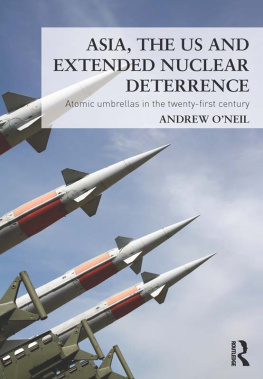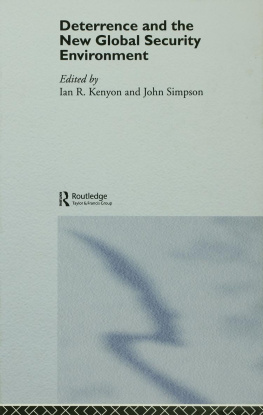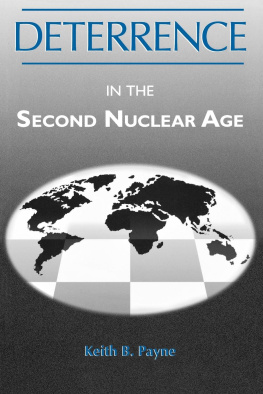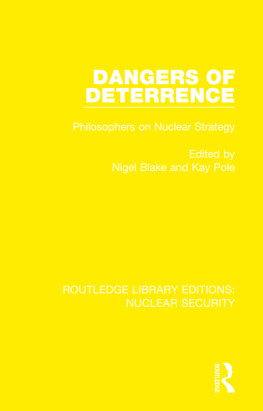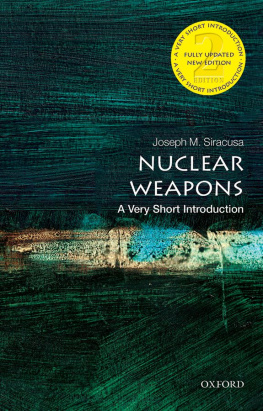ASIA, THE US AND EXTENDED NUCLEAR DETERRENCE
Since the end of the Cold War, significant attention has focussed on the issue of nuclear deterrence and in particular whether formal nuclear security guarantees from nuclear weapons states to non-nuclear weapons states involving the possible use of nuclear weapons have a place in the twenty-first-century global strategic landscape. Growing support for nuclear disarmament in the US and elsewhere has seen serious doubts being raised about the ongoing utility of extended nuclear deterrence
This book provides the first detailed analysis of the way in which extended nuclear deterrence operates in contemporary Asia. It addresses the following questions: What does extended nuclear deterrence in Asia tell us about the broader role of extended nuclear deterrence in the contemporary international system? Is this role likely to change significantly in the years ahead? O'Neil uses a theoretical and historical framework to analyse the contemporary and future dynamics of extended nuclear deterrence in Asia and challenges many of the existing orthodo perspectives on the topic.
Providing a new perspective on debates surrounding extended nuclea deterrence, this book will be of interest not only to students and scholars o Asian politics, international relations and security studies, but also to policy maker and professionals.
Andrew O'Neil is the Director ofthe Griffith Asia Institute and a Professor in the School of Government and International Relations at Griffith University. Before entering academia in 2000, he was a strategic analyst with Australia's Intelligence Community. He is the author of Nuclear Proliferationin Northeast Asia: The Questfor Security (Palgrave Macmillan, 2007).
ASIA, THE US AND EXTENDED NUCLEAR DETERRENCE
Atomic umbrellas in the twenty-first century
Andrew O'Neil
First published 2013
by Routledge
2 Park Square, Milton Park, Abingdon, Oxon, OX14 4RN
Simultaneously published in the USA and Canada
by Routledge
711 Third Avenue, New York, NY 10017
Routledge is an imprint of the Taylor & Francis Group, an informa business
2013 Andrew O'Neil
The right of Andrew O'Neil to be identified as author of this work has been asserted by him in accordance with sections 77 and 78 of the Copyright, Designs and Patents Act 1988.
All rights reserved. No part of this book may be reprinted or reproduced or utilised in any form or by any electronic, mechanical, or other means, now known or hereafter invented, including photocopying and recording, or in any information storage or retrieval system, without permission in writing from the publishers.
Trademark notice: Product or corporate names may be trademarks or registered trademarks, and are used only for identification and explanation without intent to infringe.
British Library Cataloguing in Publication Data
A catalogue record for this book is available from the British Library
Library of Congress Cataloging in Publication Data
O'Neil, Andrew.
Asia, the US and extended nuclear deterrence : atomic umbrellas in the 21st century/Andrew O'Neil.
p. cm.
Includes bibliographical references and index.
1. Nuclear weaponsAsia. 2. Nuclear arms controlAsia. 3. Deterrence (Strategy)Asia. 4. Security,
InternationalAsia. 5. AsiaMilitary relationsUnited States. 6. United StatesMilitary relationsAsia.
I. Andrew O'Neil.
UA830.O54 2013
355.0217dc23
2012036080
ISBN: 978-0-415-64493-8 (hbk)
ISBN: 978-0-415-64494-5 (pbk)
ISBN: 978-0-203-37453-5 (ebk)
Typeset in Bembo
by OKS Prepress Services, Chennai, India
For Dean Jaensch, my first and most inspirational contact with the discipline of Political Science
CONTENTS
PREFACE
My interest in extended nuclear deterrence flows from a broader intellectual fascination with how political will and influence are exercised in international relations. The deeper I delved into the topic of America's nuclear umbrellas in Asia, the more convinced I became that the area worthy of further study was how the United States interacted over time with allies, rather than with adversaries. Of particular interest is the relationship between supply and demand in shaping extended nuclear deterrence relationships in the region. Adversaries, real and imagined, are of course important in this process, but it is demand from allies that determines the buoyancy or otherwise of the nuclear umbrella in any given context As I argue in the book, demand for the nuclear umbrella in Asia is at historically high levels and shows no signs of abating. Despite President Obama's reaffirmation of America's commitment to nuclear disarmament, Washington has in recent year strengthened extended nuclear deterrence guarantees to key allies in Asia. Indeed, nuclear weapons have never been more salient in America's key Asian alliance relationships as they are today. This book seeks to explain why, through an investigation of the historical and contemporary features of extended nuclear deterrence in Asia.
By far the best part about writing a book is being able to thank the people who made it possible. The person who bears most of the responsibility for this book's origins (as distinct from its substantive content) is Rory Medcalf, Director of the International Security Program at the Lowy Institute for International Policy. I 2010, as part of a project on extended deterrence sponsored by the Nuclear Threat Initiative, Rory invited me to participate in a series of regional workshops in Beijing, Seoul, Sydney, and Tokyo. These workshops were enormously beneficial in providing a window into contemporary thinking about the role of the nuclear umbrella in Asia.
Many individuals contributed their precious time very generously in various conversations on aspects of the book. I would particularly like to express my thanks to the following people: Muthiah Alagappa, Kim Beazley, Paul Dibb, Zhu Feng Stephan Fruhling, Peter Jennings, Ken Jimbo, Hyun-Wook Kim, Hans Kristensen, Rod Lyon, and Hugh White. For excellent research assistance, I am grateful to Katja Cooper. I would also like to thank Tong Fi Kim, who read through sections of the manuscript and offered insightful suggestions. Thanks are also due to two anonymous reviewers who provided important feedback on early draft chapters. I am grateful to Leanne Hinves at Routledge who provided positive encouragement over the life of the project and Julian Roskams, whose patient assistance with the final copyediting was first-rate.
I have been fortunate to have had the support of stellar colleagues and friends whose encouragement made more of a difference than any of them probably appreciated. Particular mention should be made of Robert Ayson, Martin Griffiths, Michael Heazle, Jason Sharman, and Bill T o w. Thanks also to Kathy Bailey, Meegan Thorley, and Natasha Vary, who tolerated with good humor a research director who was sometimes a bit too preoccupied with directing his own research.
Finally, the love and friendship of my wife Jo Fox has made this project far easier than it otherwise would have been. With our two children, Matilda and Hannah, Jo endured many work-filled weekends and made more than the usual share of sacrifices during the preparation of this book. Family love and fun is the best leveller of high-minded scholarly reflection, and this book ultimately owes more to the first ingredient than to the second.

